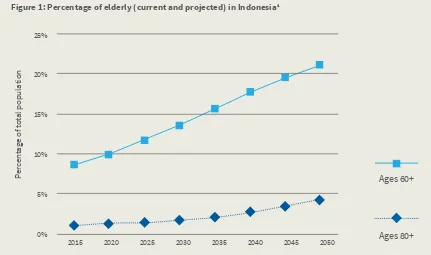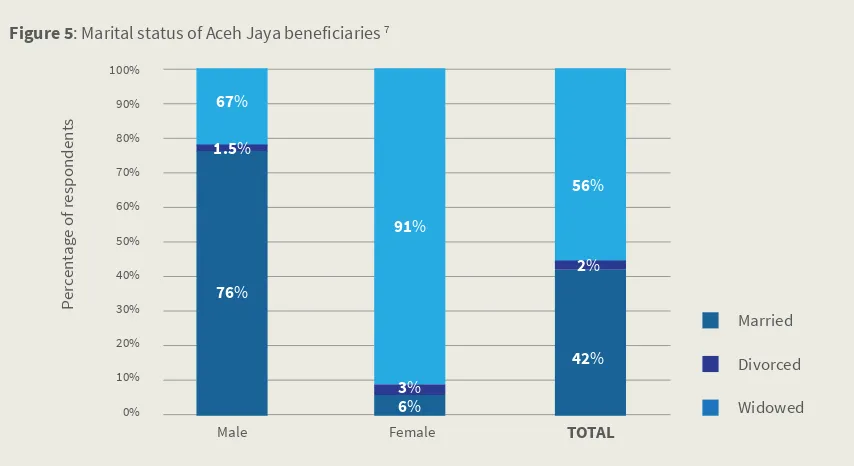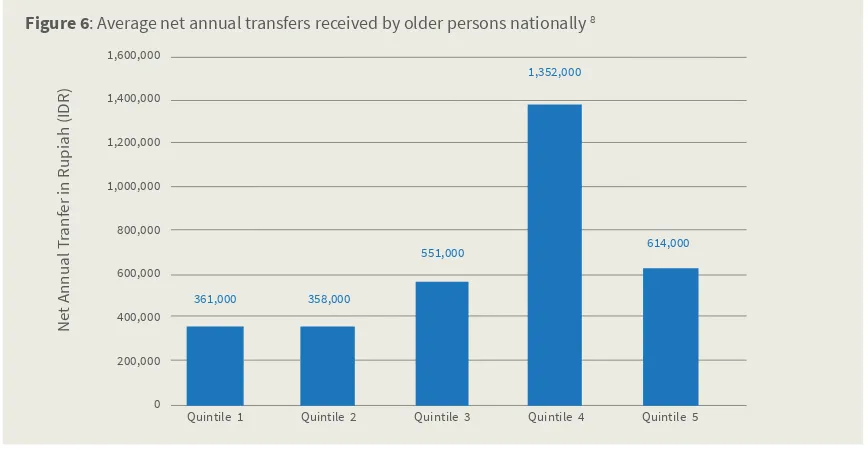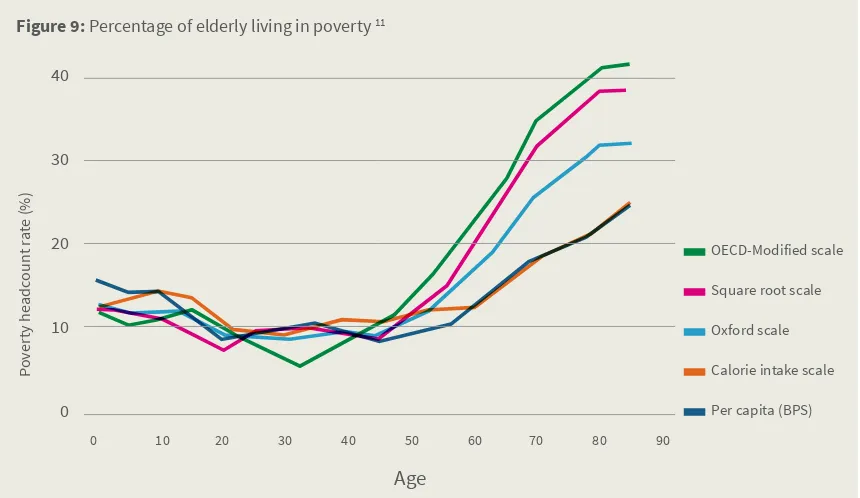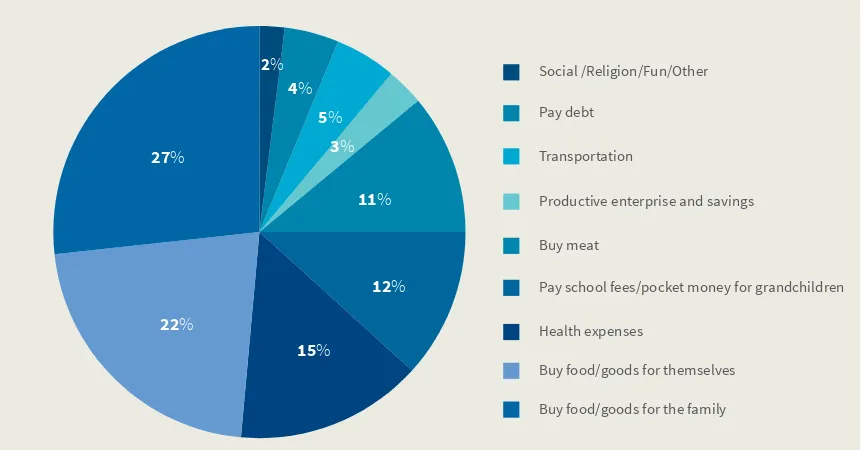1
CASH TRANSFERS FOR THE ELDERLY
TO ADDRESS POVERTY AND
STIMULATE ECONOMIC GROWTH:
An Evaluation Of Aceh Jaya’s
Old-Age Cash Transfer
01.
Introduction
Despite progress made in reducing the national poverty rate, poverty among vulnerable groups in Indonesia remains alarmingly high. Indonesia is an aging society, with an elderly population of approximately 20 million people, or 8% of the total population (TNP2K, 2014), but there is very limited income security for the vast majority of the elderly. It is projected that the population of people aged over 60 will reach 70 million people, or 21% of the population, by 2050 (see Figure 1), and the lack of economic protection for the elderly raises serious policy concerns.
1 Old-Age Poverty in Indonesia: Empirical Evidence and Policy Options – A Role for Social Pensions (TNP2K, 2014)
Figure 1: Percentage of elderly (current and projected) in Indonesia1
P
er
cent
ag
e of t
ot
al population
2015 2020 2025 2030 2035 2040 2045 2050 25%
20%
15%
10%
5%
0%
Ages 60+
3 2
In Indonesia, only 11% of elderly receive a pension. Most of these people are former
civil servants and military personnel. In 2006, Indonesia created its irst cash transfer
program (ASLUT) that focuses exclusively on the elderly. By 2013, ASLUT was operational in all Indonesian provinces and currently provides approximately 30,000
poor and bed-ridden beneiciaries over the age of 65 with a transfer of IDR 200,000
per month. While a step in the right direction, ASLUT covers only a tiny fraction (0.15%) of Indonesia’s elderly population.
Sub-national governments are showing a strong commitment and innovative
methods to illing these gaps in coverage – particularly in the province of Aceh where they have access to special autonomy funds. Recent consultations with Aceh’s provincial local government demonstrated both the political will and iscal capacity to
provide income transfers to vulnerable groups across the life-cycle. Several districts within Aceh are implementing inclusive cash transfers for children, the elderly, and people with disabilities. Internal monitoring records and anecdotal evidence shows initial positive impacts, including a reduction in inequality and poverty within the
respective districts. In Aceh Jaya district, speciically, every person over the age of 70 receives a cash transfer of IDR 200,000 per month, with coverage of 2,709 beneiciaries2.
The initiative, called the High-Risk Elderly Social Assistance Program (ASLURETI),
is lauded as successful and progressive by both provincial and national authorities. During a recent visit to Aceh Jaya, the district-level Department of Planning (Bappeda) requested MAHKOTA, an Australian Government-funded program supporting
Indonesian Government eforts to reduce poverty and inequality, and TNP2K, Indonesia’s National Team for the Acceleration of Poverty Reduction, for support to conduct an evaluation of ASLURETI in order to help secure future district-government
funding (APBD) for the program. This also provided MAHKOTA and TNP2K with the
opportunity to collect evidence of the efectiveness of such a scheme, and inform
national level thinking around existing policies and income transfer instruments to address old age poverty.
2 The budget envelope for this scheme is 6.5 billion IDR for 2017, and covers all the elderly in Aceh Jaya
02.
Description of ASLURETI
ASLURETI is a cash transfer scheme, also known as a social pension, for the elderly.
It is a district program, driven by a philosophy that the elderly are amongst the most
vulnerable in the community, and are entitled to a digniied life. Furthermore, because the program facilitates the elderly to register their identity to access ASLURETI
beneits, it has also provided an opportunity for the Aceh Jaya government to update
its civil records post-tsunami.
Initially, ASLURETI targeted elderly aged 60 and above, but due to iscal constraints,
the district government increased the eligibility age to 70. The district government stated that they preferred to increase the eligibility requirements rather than select
the ‘poorest’ among the elderly as a way of creating iscal space.
According to the former District Head (Bupati), Ir Azhar Abdurrahman,
“All the elderly in Aceh Jaya are vulnerable and often neglected, even if they live in
better-of households. We have a responsibility to ensure the dignity and well-being better-of every elderly person, not just those from the poorest households.”
In an efort to develop an evidence base that could support the continuance,
expansion, and replication of ASLURETI, an evaluation of the program (commissioned
by MAHKOTA) was designed and implemented in early 2017 by SurveyMeter. The study covered 36 villages, equally covering coastal and non-coastal. The survey team conducted 540 quantitative surveys across the focus area, complimented by in-depth
interviews and focus group discussions with 40 beneiciaries, caretakers, community members, and district oicials. Special care was also taken to ensure that women and
people with disabilities were adequately covered among the respondents.
Given that no baseline was conducted at the start of the program, much of the evaluation content is drawn from retrospective input from respondents. As such, the goal of this evaluation was to provide relevant insights into how the program is
functioning, and how the scheme is afecting the lives of beneiciaries.
03.
Evaluation Methodology
Eligibility requirements for
ASLURETI are:
•
High-risk elderly (> 70 years old)•
Possessing Aceh Jaya’s Identiication Card(National ID /KTP and Family Card)
•
Residents of Aceh Jaya, irrespective of thelength of residency
•
Not a beneiciary of the national ASLUTprogram.
ASLURETI funds are typically distributed during Ramadan and prior to Idul Fitri
and Idul Adha, equating to a quarterly
disbursement of IDR 600,000. According
to the Bupati, this is purposefully done:
“These are the moments where the elderly are contributors and not just recipients – it changes the dynamic that they have with their families in a positive way, and they feel empowered.”
5 4
4.1 Prevalence of disability
Analysis of national data shows that disability becomes more prevalent with old age, and severe disability is generally an issue for those over the age of 60 (see Figure 3).
4.2 Marital status and support systems
Nationally, older women are also less likely to receive support from their spouses, given the high percentage of female widows over the age of 60, as compared to men (Figure 4)
We see similar trends in the Aceh Jaya context, where 17% of respondents
experienced some form of disability. Notably, disability in old age is a gendered issue, with more females in Aceh Jaya with a disability (22%) as compared to males (12%) .
6 ibid
7 Source: Evaluation of ASLURETI, Aceh Jaya’s Old Age Pension (MAHKOTA and SurveyMeter, 2017)
04.
A description of ASLURETI beneiciaries
In general, the program was found to be well-targeted, with only two respondents (out of the 540-respondent sample) as being under the program’s target age of 70
years and above. Sixty-seven percent of respondents were aged 70-79 years old, and
33% aged 80 years and above (Figure 2).
3 Source: Evaluation of ASLURETI, Aceh Jaya’s Old Age Pension (MAHKOTA and SurveyMeter, 2017) 4 Source: IFLS (2007-2015)
Figure 2: Percentage of respondents per age group3
Age group < 70 years
Male Female TOTAL
Age group 70-79 years Age group 80+ years 100%
Figure 3: Percentage of elderly with a disability (using Activities of Daily Living measures) at the national level 4
40%
30%
20%
10%
0% 15-19 20-24 25-29 30-34 35-39 40-44 45-49 50-54 55-59 60-64 65-69 70-74 75+ Severe disability
Age group
Disability
Figure 4: Percentage of elderly who are widowed at the national level 6
Males
e of people wido
w
ed
This situation is exacerbated in the Aceh Jaya context, where more than half the
respondents are widowed, of which 91% are women (see Figure 5). Qualitative
interviews suggest that this can be attributed to the fact that males typically remarried after the tsunami, whereas women generally remained unmarried.
Figure 5: Marital status of Aceh Jaya beneficiaries 7
7 6
This has considerable consequences on the support networks that the elderly –
particularly females - can draw on. Nationally, a much higher share of women over the age of 60 live alone as compared to men. In Aceh Jaya, 27% of respondents live alone (of which 40% are women, and 12% are men). There is a common misperception that the elderly are cared for by their communities and extended families, and therefore do not need additional income support from the state. This is widely challenged through both international and national evidence.
Nationally, we see that 40% of older persons receive no inancial support at all from
their families and neighbors, and those in poorest quintiles receive less than 400,000
IDR in transfers (cash or in-kind) from other households annually (see Figure 6)
8 Source: Susenas (2015)
Figure 6: Average net annual transfers received by older persons nationally 8
1,600,000
er in Rupiah (IDR)
In Aceh Jaya, 90% of respondents claim that they receive some transfers from their
families or communities, but the majority state that the amount is not enough to meet their needs. Six percent state that they do not receive any assistance, and must engage in paid work to support themselves.
4.3 Employment
At the national level, nearly 80% of males, and 50% of women, still engage in paid work over the age of 60 (see Figure 7), which highlights that the elderly are often required to work despite frail health and physical limitations of old age.
We see similar trends in Aceh Jaya, where 40% of respondents still undertake paid work on a weekly basis (56% of men, as compared to 23% of women, and 12% of people with disabilities) (see Figure 8).
Figure 7: Percentage of people working according to age at the national level 9
Males
10 Source: Evaluation of ASLURETI, Aceh Jaya’s Old Age Pension (MAHKOTA and SurveyMeter, 2017)
100
Figure 8: Percentage of ASLURETI beneficiaries engaged in paid work 10
Unemployed/
Male Female Disabled TOTAL
44%
9
8
4.4 Income and asset ownership
National data also shows that poverty rates steeply increase as people get older. In
fact, poverty estimates using the national socio-economic survey (SUSENAS) data
may under-estimate the severity of old-age poverty, as the rates are much higher
using other international equivalence scales (see Figure 9).
Figure 10: ASLURETI beneficiaries’ monthly income (by sex and geographic areas) 12
Figure 9: Percentage of elderly living in poverty 11
40
Although ASLURETI does not target beneiciaries based on poverty levels, most beneiciaries are among the poor and vulnerable. On self-reported income, 74% of all elderly (94% of women, and 66% of men) earn below 1 million Rupiah ($100 AUD) per
month (see Figure 10).
100%
Monthly income > 1 IDR million
Male Female TOTAL
Monthly income < 1 IDR million 6%
94%
66%
34% 26%
74%
Furthermore, only 17.5% of respondents admitted to holding any savings or physical assets which they can draw on to cope with crises or shocks.
11Source: SUSENAS (2015)
12Source: Evaluation of ASLURETI, Aceh Jaya’s Old Age Pension (MAHKOTA and SurveyMeter, 2017)
4.5 Education levels
Adequate employment opportunities are inextricably linked with levels of education. In the context of Aceh Jaya, most respondents (77%) have never attended school, or not completed elementary school. Furthermore, only 3% of respondents have completed schooling higher than elementary. There is a strong gendered dimension,
as 87% of women have not attended nor inished elementary school, as compared to
67% of men (see Figure 11)
Figure 11: ASLURETI beneficiaries’ education levels 13
No school (n=221) Not completed Elementary School (n=197) Male
Completed Elementary School (n=97) Completed Junior School (n=15) Completed Senior High School (n=8) Attended University (n=2)
Percentage of respondents (%)
0 10 20 30 40 50 60 70 80 90 100
As a result, nearly 74% of female respondents are unable to read or write, as compared to 37% of men.
While years of schooling are extremely low within elderly populations, male respondents average at least twice the amount for schooling years than females in
the 70-79 age group (3.36 years compared to 1.64), and almost tripled in the 80-plus aged respondent group (2.80 years as compared to 0.95).
11 10
4.6 Access to social protection programs
There is clearly a need for state support to address old-age poverty, and enhance
income levels for older persons in Aceh Jaya. In addition to ASLURETI, 94% of respondents are also recipients of the national subsidized rice scheme (Rastra), and 91% are also beneiting from the national social health insurance scheme (JKN). Sixty-one percent also beneit from a local program which provides free electricity, while
access to other cash transfer schemes was negligible.
However, the majority (54%) claimed that ASLURETI was the most beneicial for them, and subsequently, JKN (21%), the free electricity scheme (13%), and Rastra (9%)
(see Figure 12)
Table 1: ASLURETI beneficiaries’ access to social protection programs 14
14 ibid
4.7 Health status and food security
Health status was self-reported, with 47% in total stating they were ‘of good health’ and capable of undertaking daily activities. Understandably, only 20% of elderly with
a disability rated their general health as good, with only 9% able to perform daily
activities.
Mental health ratings were undertaken using the Centre for Epidemiologic Studies
Depression Scale, and found that around 40% of respondents, and their caregivers, experienced some form of depression. There were higher rates of depression found in female respondents compared to males, although reasons for this remain unclear.
Using a food security measurement developed by Freedom from Hunger, respondents were found to mostly live within food-secure households. From the 16% of respondents in a food insecure household, 12.5% lived in a moderately food insecure household, while 3.5% were found to be severely food insecure.
SOCIAL ASSISTANCE PROGRAM
Cash transfer from Baitul Amal Home repair for Elderly
Family Hope Program (PKH) Other
Figure 12: Most beneficial social protection schemes for ASLURETI beneficiaries
ASLURETI
05.
ASLURETI Evaluation Findings
5.1 The use of the cash transfers
There was great variation in the use of the transfers, but almost 50% of respondents
used their ASLURETI income for purchasing food and daily needs for themselves and
their families. In addition, using the funds to pay for health expenses, expenses for their grandchildren, and purchasing meat during special occasions also registered as
signiicant areas of spending. Interestingly, females and those with a disability were
much more likely to spend their cash on health expenses, while male respondents primarily used the income for daily needs for themselves and their households.
Figure 13: Average Percentage of spending of the ASLURETI payments 15
Social /Religion/Fun/Other
Pay debt
Transportation
Productive enterprise and savings
Buy meat
Pay school fees/pocket money for grandchildren
Health expenses
Buy food/goods for themselves
Buy food/goods for the family
13 12
While only a few respondents (3%) used the money for savings or productive
purposes, ASLURETI also gave some beneiciaries an opportunity to put money
away for their future needs. For instance, qualitative interviews showed that many
beneiciaries saved money for emergencies, as well as for their own funeral costs.
Several respondents invested in small shops; livestock for breeding and selling; and some invested in arisan (rotating savings groups) as a way of growing their capital.
One beneiciary stated that he can no longer work as a isherman given his frailty, and saved the ASLURETI funds to open a small shop, which he runs together with his son.
“This shop is our future now, and my grandchildren also help here after school.”
While only 24% of respondents stated that the amount of IDR 200,000 was adequate to meet basic needs, 99% felt that it had improved the quality of their lives and the
lives of their caretakers, for the following reasons:
• 81% of respondents stated that they can now contribute to family expenses
(namely rice, sugar, cofee, and eggs for the family, and clothing as well as soap
for themselves).
• 74% experienced better access to health services, typically because they can
ofset transport costs and visit health facilities more frequently (see Section 5.2)
• 95% experienced a greater sense of autonomy and dignity
Per an 85-year-old widowed respondent,
“I am the sole carer for myself and my disabled son. ASLURETI helps with our food costs, but during each payment cycle, I put away some money for my son’s medical costs. This way, if he urgently needs to see a doctor, I don’t need to stress and beg others for help.”
Mulyadi, 74 years old, a beneiciary of ASLURETI in his small shop in Alue Ambang
village, Teunom, Aceh Jaya, Aceh Province, Indonesia. (Photo by Fauzan Ijazah/ MAHKOTA)
Ramli with his wife, both are beneiciaries of ASLURETI programm from Pasie Raya
village in Aceh Jaya, Aceh Province, Indonesia. (Foto oleh Fauzan Ijazah/MAHKOTA) 5.2 Health
In general, respondents were now more likely to access health services after
the implementation of the ASLURETI program, and less likely to undertake self-medication. While this is likely inluenced by access to other assistance programs
(particularly JKN), 60% of respondents claim that they can visit health centres more frequently because they can pay for transportation costs, and purchase medicines not covered by JKN.
Interviews with carers also found that these investments improved inter-family
relationships. According to an 80-year-old beneiciary with a range of disabilities,
“With the ASLURETI funds, I do not have to ask money from my son to buy every day medicine. Also, I can contribute for fuel for his motorbike, which helps with the costs of taking me to the doctor.”
Over 70% of respondents experienced improvements in their emotional health, which they attribute to greater respect from their families, and greater independence and
self-conidence.
5.3 Family
Put simply, ASLURETI has contributed to shifting the status of the elderly from dependents to contributors. The reliance on children to fulil everyday needs can
contribute to a strained relationship, and the respondents typically felt this with their children in-law. The ability to contribute resources to the household economy has started to change this dynamic, as captured by the quote below:
15 14 16 Old-Age Poverty in Indonesia: Empirical Evidence and Policy Options – A Role for Social Pensions (TNP2K, 2014)
5.4 Community
Around 85% of respondents agreed that the ASLURETI program improved their status
and engagement within their communities. They are increasingly able to donate to
charities (e.g. mosques, orphanages, etc.), inancially contribute to ceremonies (and thus more readily attend social events), and provide inancial support to a neighbour
when in need. Most respondents claimed that such contributions also changed the way that others viewed them, and they were seen to be more active and engaging as
compared to before ASLURETI. According to a Village Leader,
“We see that the elderly around here attend more events, and give more to the mosques and orphanages. Last night I saw an elderly couple at a wedding, and normally they would decline, as they’d be unable to contribute. Sometimes they can only gift IDR 30,000, but the point is that they are more active now, and we all notice this.”
Furthermore, interviews with local business owners also suggest that the elderly are now more active consumers. They purchase more goods from the local shops, and shop owners are more likely to sell to the elderly on credit, knowing that they can now repay. As one local shop owner stated, “previously, some of the elderly in this
village could only aford to buy half a kilo of sugar. Now they can buy one kilo, and some eggs, and they come to me more frequently.”
Interestingly, local business owners also noted decreased economic dependence of elderly residents on their immediate family and friends.
5.5 Care Givers
Overall, 80% of caregivers interviewed claimed that their lives have improved since
receiving ASLURETI (while 20% feel that there is no change). Most caregivers (60%)
feel that they now have more time for themselves; 58% claim that they can focus more of their resources on their children; and 65% state that the household eats
better because of ASLURETI.
International literature also highlights the importance for the elderly to purchase
gifts for relatives – typically grandchildren – as a way of strengthening the social
contract between the elderly and those around them. In the Indonesian context, the
elderly have always been signiicant contributors for younger generations, but these
contributions have been in considerable decline 16. In Aceh Jaya, respondents used approximately 12% of their cash transfers for their grandchildren – namely as pocket
money or to purchase snacks. Some respondents said that their grandchildren came to them, rather than their parents, when in need of money (e.g. for transport costs when searching for employment). Nearly all respondents said that the small
The ASLURETI evaluation has demonstrated that regular and
predictable cash transfers to the elderly can provide much needed
economic support for the elderly as well as their caregivers; and
strengthen social ties within the families. Bappeda’s internal monitoring
records also show that ASLURETI has helped the local government to
reduce poverty from 19% to 16%, exceeding its target for the current
RPJMD.
As demographics in Indonesia shift, and Indonesia becomes aging
society, critical policy decisions must be taken. Indonesia remains the
only country in Asia to rely on contributory pensions to support the
elderly, and one of the only countries globally to not yet introduce a
social pension
17.
However, through modest iscal spending (.19% of GDP), Indonesia
can introduce an inclusive old-age cash transfer for 300,000 IDR a
month for everyone over the age of 70, which would yield signiicant
reductions in national poverty levels. The costs can be lowered even
further by setting the eligibility age at 80, as many countries have done
to create iscal space.
A cash transfer for the elderly should be regarded as an investment
that will help stimulate the economy and lower national poverty levels.
Consequently, it should not be regarded only as a beneit for the
elderly, but rather, a scheme beneitting all citizens of Indonesia
18.
A way forward
17 Other countries in the Asia region have taken steps to introduce comprehensive pension systems in recent years. Thailand
and Mongolia provide almost universal pension coverage through a mix of social and contributory pensions; East Timor has in place asocial pension for everyone over 60 years; China provides pensions to 125 million older people; Vietnam and Myanmar provides an old age pension guaranteed for everyone over 80 years; Nepal has social pensions that reach most over 70s; Bangladesh, India and the Philippines – have set up social pensions targeted at the older people living in poverty, which are gradually expanding (Kidd, 2013)
through the MAHKOTA Program. This document is a draft and is provided for information only. The information contained herein is subject to change and is currently undergoing review by the MAHKOTA Program.
The quotes in this document have been edited for clarity, and are not literal translations of the original interview transcript.
@ August 2017
For more Info:
MAHKOTA Oice:
Level 8, Grand Kebon Sirih, Jalan Kebon Sirih 35, Jakarta Pusat 10110, Indonesia
